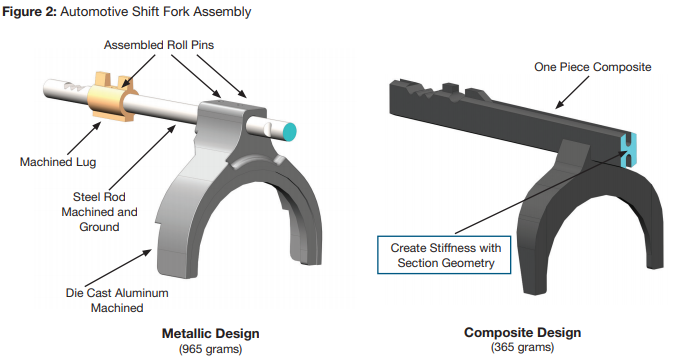Designers need to be mindful of the fabrication process. In Figure 2, the steel rod is round because this is a common shape of steel stock. The mating parts have easily-machined round holes that can be assembled onto the round rod. The composite designer had to achieve the same stiffness, which was accomplished by changing the cross section of the rod component. The designer also had to consider the attachment of the mating parts. In the case of this example, a few of the mating parts have been molded directly onto the rod.
Design analysis and modeling with composite materials is now a discipline that is being used by more and more engineers. Engineers in the industry acquire an “empirical” knowledge to instinctively design with composite materials that grows with experience. Errors are commonly encountered when non-composite focused engineers try to substitute a composite material in a metallic design or model it as a metallic material. The metallic design is usually not the optimum design for composite materials.
Composite parts can be tailored in a variety of ways. This tailoring can take place in either the part fabrication process or within the material itself. Parts can have localized reinforcement, directionally oriented fibers or more fibers in one direction without added unwanted thickness. As an example, laid-up parts may have more unidirectional fiber layers in the direction of the load path, but enough fiber layers in other directions to handle the forces required in those other directions. Wound parts can have winding angles changed to enhance the properties in specific directions. Random fiber compression molded parts may have localized continuous fiber material added in areas requiring extra strength or stiffness. Similarly, bythe nature of being a “composite” made up of multiple elements, the individual materials themselves are often more easily tailored to meet specific characteristics or even fit a specific application.
Composites allow for tailorable solutions. The performance or value is not only in mechanical properties or weight, but also includes aesthetics, conductivity, thermally insulative, ballistic or impact resistance, flame/smoke/toxicity compliance or other valued-added attributes.
To summarize, composite design is a complex process that requires consideration of key drivers, including cost, weight, performance, part count and complexity. The relative priority will be influenced by service loads, service environment/performance, connections, specific part requirements, anisotropic properties and the fabrication process. These were briefly touched upon in this column, but all deserve a deeper look to ensure optimal design.


